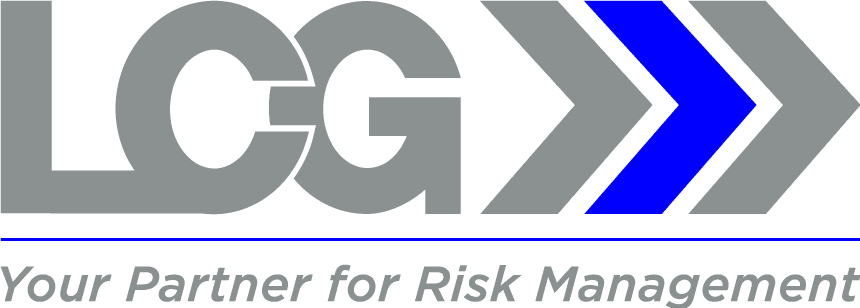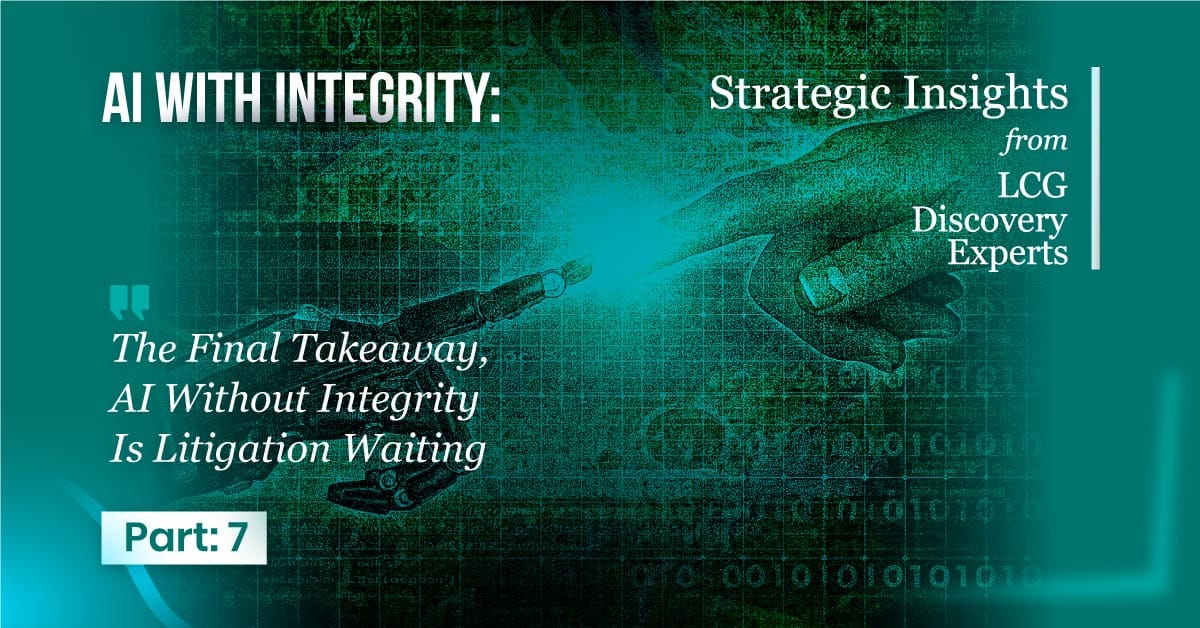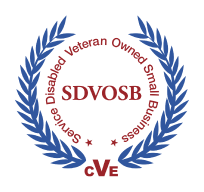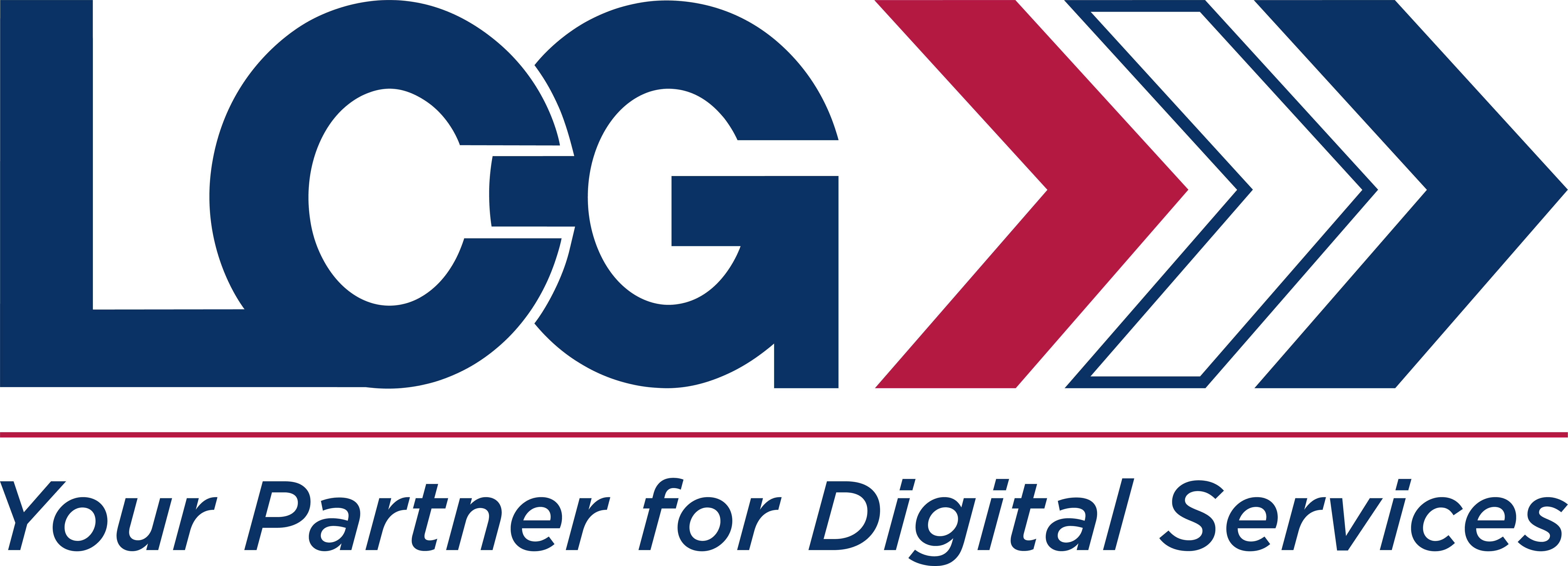Contributed by Thane Russey, VP, Strategic AI Programs
Series context. This concludes the seven-part AI with Integrity series, focused on building defensible, measurable, and transparent AI systems that withstand courtroom scrutiny and enterprise risk audits. [1]
The Litigation Risk Hiding Inside AI
Artificial intelligence is transforming how investigations, compliance reviews, operational oversight, and digital evidence processing are performed. But as organizations accelerate deployment, a pattern is emerging in courts, enforcement actions, and regulatory guidance: AI that cannot demonstrate integrity is not an asset. It is a liability.
Judges, regulators, and opposing experts are no longer impressed by efficiency alone. They are asking how outputs were generated, validated, audited for bias, logged, preserved, and supervised. These demands reflect established rules and standards, including Federal Rules of Evidence 702 on expert admissibility [2], Sedona Conference principles on transparency and process validation [3], and ISO and NIST frameworks that require traceability, data quality controls, and lifecycle governance. [4]
When AI-generated content is used as evidence, or when decisions informed by AI face legal challenge, the question is not whether the model performed well. The question is whether the results are provably trustworthy.
LCG perspective. From a forensic and risk-management standpoint, the point of failure is nearly always the same: organizations treat AI as a clever tool rather than a regulated evidence-producing system. [4]
What Courts Expect from AI Evidence
Courts and regulators are converging around four pillars of defensibility. When any of these are absent, the risk of exclusion, sanctions, or reputational damage increases.
- Traceable outputs with human oversight
- Documented chain of reasoning or traceable model operations.
- Human review steps are captured in the workflow.
- Clear identification of all data sources used for inference.
- Preservation of intermediate states when needed for expert challenge.
These expectations mirror FRE 901 requirements for authenticating evidence [5] and NIST AI RMF provisions on transparency and explainability. [6]
- Verified, tested, and bias-audited processes
- Independent validation of training data quality.
- Quantified error rates consistent with reliability requirements under FRE 702.
- Regular bias assessments aligned with ISO/IEC 42001 and NIST RMF fairness controls. [6]
- Documentation of model updates, versioning, and patch histories.
Courts increasingly treat model validation like any other technical expert methodology.
- Immutable custody chains
- Event-level logs are preserved in accordance with ISO/IEC 27037 digital evidence handling principles. [7]
- Non-overwritable, time-stamped records of model inputs, parameters, and outputs.
- Cryptographic or policy-based protections on audit logs.
- Formal handoff records when evidence transitions between systems or people.
AI-generated evidence without a defensible chain of custody is simply inadmissible.
- Transparent policies and expert readiness
- Enterprise-wide AI governance policy that aligns with NIST, ISO, and DOJ guidance. [8]
- Internal subject matter experts are prepared to explain model operation and limitations.
- Evidence of continuous monitoring, not one-time validation.
- Documented incident response processes for AI malfunctions.
Courts expect organizations deploying advanced automation to explain the tools well enough to be cross-examined.
The Cost of Getting It Wrong
The legal consequences of unintentionally using non-defensible AI systems are becoming clearer across litigation, regulatory examinations, and public-sector oversight:
Exclusion of key evidence.
If a model’s workings cannot be explained or validated, opposing counsel can move to exclude the outputs under FRE 702 reliability challenges. Several cases in digital forensics show that incomplete logging, inconsistent validation, or undocumented processes can invalidate entire collections or analysis steps. [8]
Sanctions and spoliation arguments.
Incomplete or overwritten AI logs can trigger claims of lost or altered evidence. Under FRCP 37(e), courts may impose sanctions if the absence of logging causes prejudice. AI tools that continuously update without preserving historical behavior are particularly vulnerable.
Unknown liabilities.
Opaque systems create risk vectors that leadership cannot fully quantify. This includes regulatory enforcement for fairness violations, downstream civil liability for automated decision-making errors, and contract disputes over due diligence failures.
Reputational harm.
High-profile misuse of AI or evidence collapse can undermine trust with customers, regulators, and partners. Once credibility is questioned in one matter, that skepticism follows the organization into every subsequent proceeding.
LCG perspective. Historically, organizations feared losing data. Today, they fear what their AI systems may have done with it and whether they can prove it. [4]
Building AI With Integrity: What Defensible Systems Require
A defensible AI ecosystem does more than avoid risk. It creates trust that stands up to courtroom examination, regulatory audit, and expert cross-analysis.
- A lifecycle governance framework
- Adopt NIST AI RMF functions: Govern, Map, Measure, Manage. [6]
- Map all AI use cases to specific risk controls.
- Assign responsible owners for data quality, model oversight, and documentation.
- Establish mandatory risk assessments before deployment or updates.
- A forensic-ready evidence posture
- Enable logging at the input, inference, and output layers.
- Maintain non-editable logs consistent with ISO/IEC 27037 expectations. [7]
- Configure retention schedules aligned with regulatory, litigation, and business needs.
- Perform periodic integrity testing to confirm that custody chain controls are working as designed.
- Transparent documentation
- Model cards or equivalent documentation describing training data, limitations, and intended uses.
- Operational playbooks for investigators, analysts, and legal teams.
- Explicit descriptions of verification steps, including error-rate analysis.
- Version-controlled update history available to legal teams.
- Human-in-the-loop oversight
- Define mandatory checkpoints that require human review.
- Ensure reviewers are trained on model capabilities and limitations.
- Require explicit signoff before outputs are used in legal or compliance decisions.
- Maintain review artifacts as part of the permanent evidence package.
- Bias testing, validation, and continuous monitoring
- Perform impact and drift assessments on a scheduled basis.
- Apply fairness testing methodologies consistent with NIST and ISO guidance. [6]
- Include peer review or independent oversight for sensitive use cases.
- Document any tuning decisions and revalidation activities.
Frameworks, Standards, Pitfalls, and Mitigations
Framework Anchors:
- Federal Rules of Evidence 702 and 901 for reliability and authentication. [2][5]
- Sedona Conference guidance on transparency, validation, and defensible process. [3]
- NIST AI Risk Management Framework for governance, transparency, and measurement. [6]
- ISO/IEC 27037 for digital evidence handling and chain-of-custody standards. [7]
- ISO/IEC 42001 for AI governance structures. [5]
Common Pitfalls:
- Treating AI as a black box instead of an evidence system.
- Relying solely on vendor transparency rather than internal validation.
- Failing to preserve logs or model versions after updates.
- Assuming that accurate outputs equal admissible outputs.
Mitigations:
- Require forensic-readiness controls as part of the procurement process.
- Perform internal or third-party validation of all AI tools.
- Align AI governance policies with established discovery and digital forensics practices.
- Conduct mock cross-examinations or tabletop exercises to test expert readiness.
Quick Checklist
- Preserve logs and chain-of-custody artifacts.
- Validate and document model performance.
- Maintain transparent, expert-ready AI governance.
Final thought
The final principle of AI with Integrity is simple: if your AI cannot withstand legal scrutiny, it cannot be trusted in operations. Integrity is not a technical feature. It is a disciplined commitment to transparency, validation, auditability, and forensic-quality evidence practices. Organizations that anticipate courtroom expectations before the code deploys will see AI accelerate decisions, not accelerate litigation risk. [9]
References (endnotes)
[1] AI with Integrity Series Overview.
https://www.lcgdiscovery.com/blog
[2] Federal Rules of Evidence 702 (Testimony by Expert Witnesses).
https://www.law.cornell.edu/rules/fre/rule_702
[3] The Sedona Conference. Best Practices for Information and Records Management.
https://thesedonaconference.org/publications
[4] LCG Discovery & Governance. Field Experience and Expert Commentary.
https://www.lcgdiscovery.com
[5] ISO/IEC 42001 Artificial Intelligence Management System Standard Overview.
https://www.iso.org/standard/81230.html
[6] NIST Artificial Intelligence Risk Management Framework.
https://www.nist.gov/itl/ai-risk-management-framework
[7] ISO/IEC 27037: Guidelines for Identification, Collection, Acquisition, and Preservation of Digital Evidence.
https://www.iso.org/standard/44381.html
[8] Representative case law on reliability, validation, and sanctions (FRE 702 and FRCP 37(e)).
https://www.govinfo.gov/content/pkg/USCOURTS-ca9-20-55603/pdf/USCOURTS-ca9-20-55603-0.pdf
[9] LCG Discovery & Governance Internal Research Notes.
https://www.lcgdiscovery.com/research
This article is for general information and does not constitute legal advice.







